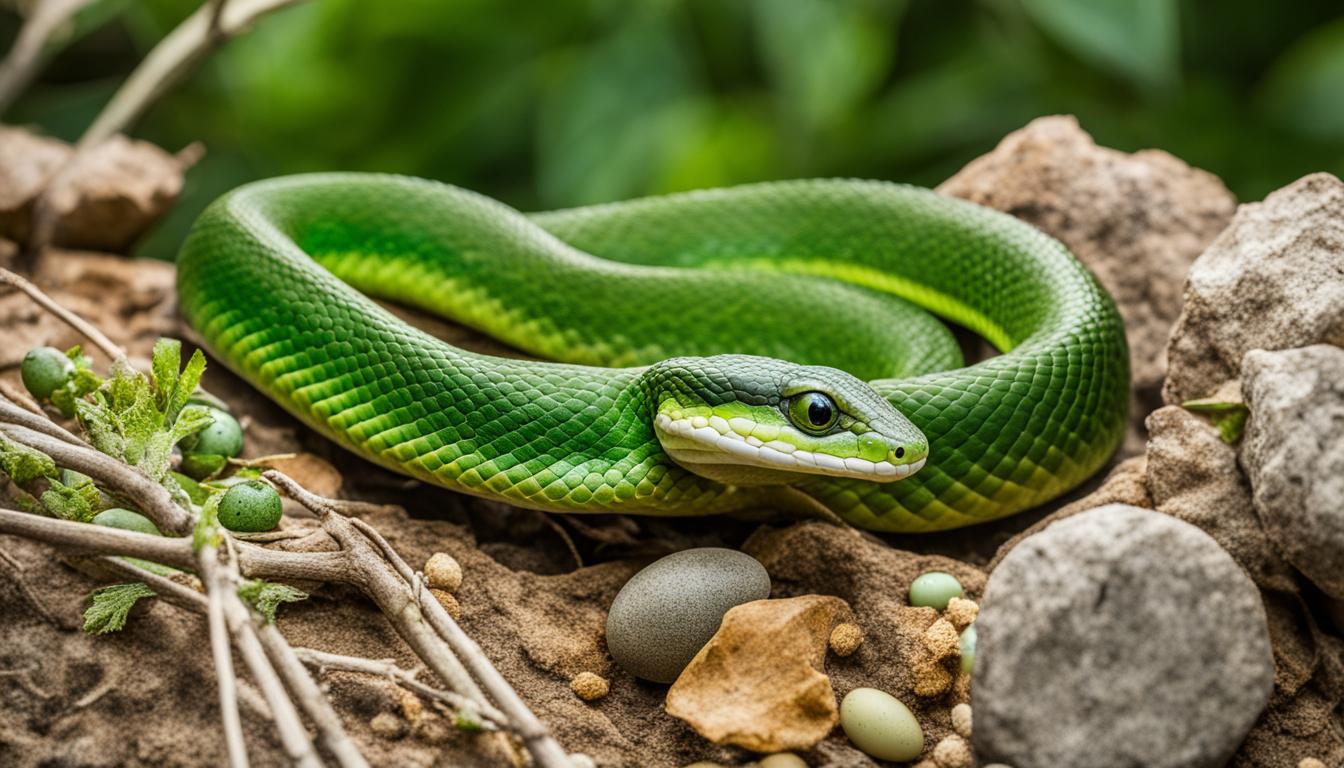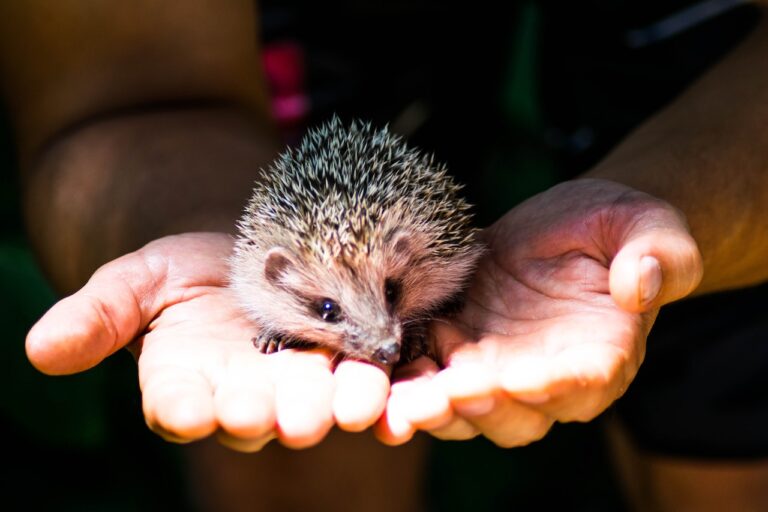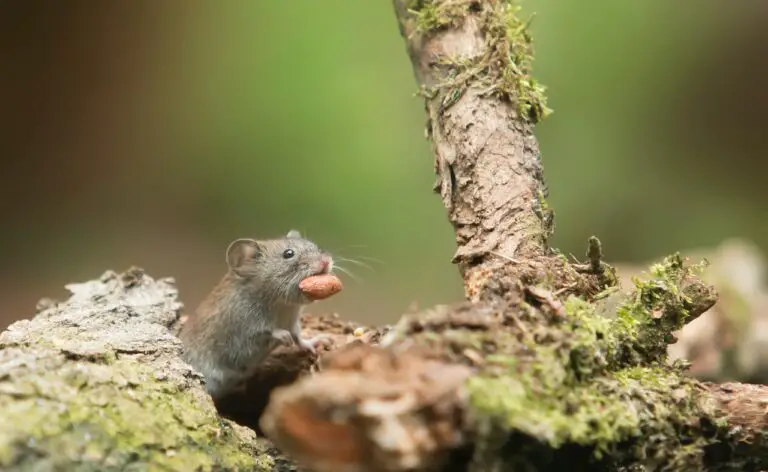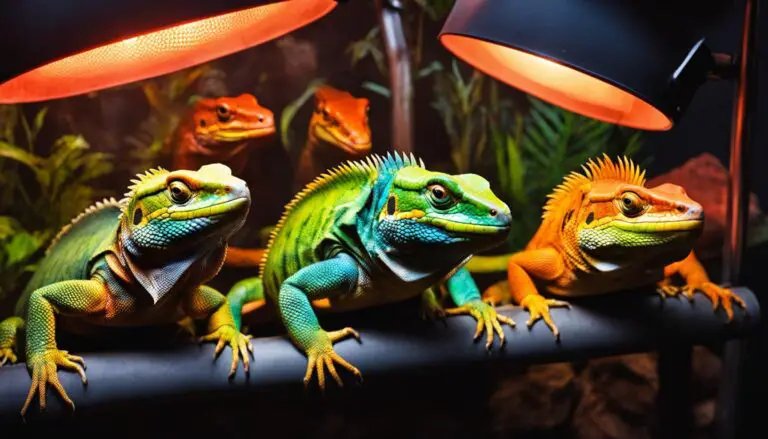Essential Reptile Breeding Tips for Hobbyists
Are you a reptile enthusiast looking to embark on the exciting journey of breeding reptiles? Breeding reptiles can be a rewarding and fulfilling hobby, but it requires careful planning and knowledge. In this article, we will explore some essential tips that will help you achieve success in reptile breeding.
Key Takeaways:
- Having a deep understanding of genetics is crucial in reptile breeding to prevent inbreeding and reproduce desired traits.
- Setting clear goals helps guide breeding decisions and increases the chances of success.
- Investing in quality breeders ensures the production of high-quality offspring.
- Be prepared for challenges such as improper nourishment, incorrect incubation temperatures, and improper care of hatchlings and juveniles.
- Knowing your limits and being realistic about the time and effort required is essential for successful reptile breeding.
The Importance of Genetic Knowledge in Reptile Breeding
When it comes to reptile breeding, having a solid understanding of genetics is essential for success. This knowledge allows breeders to make informed decisions, prevent inbreeding, and produce high-quality offspring. Whether you’re a beginner or an experienced breeder, having a grasp of reptile genetics is a valuable tool.
Genetic knowledge plays a crucial role in various aspects of reptile breeding. For starters, it helps breeders avoid inbreeding, which can lead to genetic issues and health problems in the offspring. By understanding the principles of inheritance, breeders can carefully select suitable mates and introduce genetic diversity into their breeding programs.
Additionally, genetics is particularly important in breeding color morphs, which are reptiles with unique and visually striking color patterns. By understanding the inheritance patterns behind these color traits, breeders can selectively pair individuals to produce offspring with desired colors and patterns. This knowledge also enables breeders to determine the appropriate market value of these color morph offspring.
Moreover, genetic knowledge empowers breeders to improve the overall quality of their reptiles over time. By studying the genetics of their breeding stock, breeders can identify and exclude individuals with undesirable traits from their breeding programs. This ensures that future generations maintain or exceed the quality standards set by the breeder, resulting in a continuous improvement in the overall quality of their reptile stock.
In conclusion, having a solid understanding of genetics is indispensable for any reptile breeder. It helps prevent genetic issues, allows for the selective breeding of desired traits, and contributes to the long-term improvement of the breeding stock. Whether you’re a beginner or an experienced breeder, investing time in learning about reptile genetics will undoubtedly enhance your reptile breeding techniques and overall success.
Genetic Knowledge in Reptile Breeding: Key Takeaways
- Understanding genetics is crucial for successful reptile breeding.
- Genetic knowledge helps prevent inbreeding and genetic issues in offspring.
- It plays a key role in selectively breeding desirable color morphs.
- Understanding genetics allows breeders to improve the overall quality of their reptiles over time.
“Genetic knowledge is the foundation of successful reptile breeding. It enables breeders to make informed decisions, select suitable mates, and produce high-quality offspring.”
| Benefits of Genetic Knowledge in Reptile Breeding | Examples |
|---|---|
| Preventing genetic issues and health problems in offspring | By avoiding inbreeding, breeders ensure the genetic health of their reptiles. |
| Breeding desirable color morphs | Understanding color genetics allows breeders to selectively produce reptiles with unique and attractive color patterns. |
| Improving the overall quality of breeding stock | By excluding reptiles with undesirable traits, breeders can continuously enhance the quality of their reptile stock. |
Setting Clear Goals for Reptile Breeding
When it comes to reptile breeding, setting clear goals is the key to optimizing your breeding success. Without a well-defined purpose and direction, you may find yourself encountering dead ends and facing unnecessary obstacles. So, how can you set clear goals for your reptile breeding endeavors? Let’s explore some successful reptile breeding tips.
Define Your Objectives
First and foremost, it is crucial to define what you want to achieve through breeding reptiles. Are you aiming to produce healthy offspring with desirable traits? Do you have specific genetic goals in mind, such as creating unique color morphs? By clearly outlining your objectives, you can make informed breeding decisions and increase the likelihood of achieving the desired outcomes.
Choose the Right Breeders
Another important aspect of setting clear goals for reptile breeding is selecting the right breeders. Ensure that the individuals you choose as breeding stock align with your objectives. Look for reptiles that exhibit the traits you wish to pass on to future generations. By carefully choosing breeders that align with your goals, you’ll be optimizing the chances of producing offspring that meet your expectations.
Avoid Overdoing It
While enthusiasm for reptile breeding is admirable, it’s important not to overdo it, especially when starting out. Instead of diving into multiple breeding groups right away, focus on a more manageable number of breeders. This approach allows you to dedicate sufficient time, resources, and attention to each breeding project, increasing the likelihood of success. As you gain experience and confidence, you can expand your breeding efforts accordingly.
“By setting clear goals for your reptile breeding endeavors, you can navigate the intricate world of reptile genetics with purpose and precision.”
Ultimately, setting clear goals for reptile breeding is essential for optimizing breeding success. By defining your objectives, choosing the right breeders, and avoiding overwhelming yourself, you increase your chances of achieving the desired outcomes and enjoying the fulfillment that comes with successful reptile breeding.
Setting Clear Goals for Reptile Breeding
| Steps | Description |
|---|---|
| 1 | Define your breeding objectives |
| 2 | Choose breeders that align with your goals |
| 3 | Avoid overwhelming yourself by starting with a manageable number of breeders |
Note: The table provides a concise summary of the key steps involved in setting clear goals for reptile breeding.
The Significance of Quality in Reptile Breeding
Quality plays a crucial role in the successful breeding of reptiles. When it comes to producing high-quality offspring, the quality of the parent reptiles is of utmost importance. Breeding animals of low quality is unlikely to yield the desired results. This is especially true in the case of breeding color morphs, where the brightness and clarity of offspring colors are influenced by polygenetic traits.
High-quality animals exhibit certain characteristics that indicate their suitability for breeding. These include good growth, proper eating habits, and overall good health. By investing in quality breeders, breeders can significantly increase their chances of successful breeding and the production of healthy offspring.
When breeding reptiles for specific traits or color variations, it is crucial to select animals of the highest quality. Their genetic makeup and overall health will greatly impact the outcome of the breeding process. By choosing high-quality breeders, breeders can ensure that the offspring inherit desirable traits, resulting in a higher overall quality of the offspring.
In order to understand and identify quality reptiles, it is essential to research and learn about the specific characteristics and standards for each species. By educating themselves about the ideal traits, breeders can make informed decisions when selecting their breeding stock.
Key Indicators of Quality in Reptiles
When evaluating reptiles for breeding purposes, the following indicators can help determine their quality:
- Good growth rate: Healthy, high-quality reptiles exhibit consistent and steady growth throughout their development.
- Proper eating habits: High-quality reptiles have healthy appetites and consume their food without any issues.
- Good overall health: Reptiles of high quality display excellent overall health, which includes clear eyes, smooth skin, and an alert and active demeanor.
By carefully selecting high-quality breeders and maintaining their health and well-being, breeders optimize their chances of successful breeding and the production of healthy offspring.
| Advantages of Breeding with High-Quality Reptiles | Disadvantages of Breeding with Low-Quality Reptiles |
|---|---|
|
|
The image above beautifully illustrates the significance of breeding reptiles of high quality. By selecting breeders with desirable traits and maintaining their health and well-being, breeders can ensure the production of healthy and high-quality offspring.
Challenges in Reptile Breeding
Breeding reptiles can be a rewarding and fulfilling experience, but it also comes with its fair share of challenges. To ensure successful reptile breeding, it’s important to be aware of the potential difficulties that may arise. Here are some common challenges that reptile breeders often encounter:
Lack of Proper Nourishment
Proper nourishment of breeding animals is essential for successful reproduction. Inadequate nutrition can lead to health issues or result in poor-quality eggs and offspring. It’s crucial to provide a well-balanced diet that meets the specific dietary needs of each reptile species. Consult reputable sources, such as experienced breeders or veterinarians, for guidance on the dietary requirements of your reptiles.
Incorrect Incubation Temperatures
Incubation temperature plays a crucial role in determining the sex of reptile offspring and ensuring their healthy development. Incorrect incubation temperatures can lead to skewed sex ratios or developmental abnormalities. It is important to thoroughly research the preferred temperature range for incubating the eggs of your reptile species and monitor it closely to achieve the desired outcome.
Improper Care of Hatchlings and Juveniles
Providing proper care for hatchlings and juveniles is vital for their growth, health, and overall well-being. Reptiles require specific environmental conditions, such as temperature, humidity, and lighting, to thrive. Inadequate care can lead to issues like stunted growth, malnutrition, or increased susceptibility to diseases. Be sure to maintain appropriate habitats, provide suitable diets, and follow professional advice to ensure the well-being of your reptile offspring.
“Proper nourishment, correct incubation temperatures, and attentive care are essential factors in successful reptile breeding.”
Seeking Advice and Preparing for Challenges
Addressing the challenges of reptile breeding requires knowledge and experience. By learning from experienced breeders and networking with other enthusiasts in the reptile community, you can gain valuable insights and guidance. Stay informed about the specific needs and breeding requirements of your reptile species through reliable sources, such as books, online forums, or herpetological societies.
Preparing for potential challenges can significantly increase your chances of success in reptile breeding. By anticipating the difficulties that may arise and acquiring the necessary knowledge and resources, you’ll be better equipped to overcome obstacles along the way.
Remember, every reptile species comes with its unique set of challenges. Stay adaptable, patient, and committed to providing the best care for your reptiles, and you’ll have a higher likelihood of achieving success in breeding these fascinating creatures.

Common Challenges in Reptile Breeding
| Challenges | Description |
|---|---|
| Lack of Proper Nourishment | Inadequate nutrition can lead to health issues and poor-quality eggs and offspring. |
| Incorrect Incubation Temperatures | Improper incubation temperatures can result in skewed sex ratios or developmental abnormalities. |
| Improper Care of Hatchlings and Juveniles | Inadequate care can lead to stunted growth, malnutrition, and increased susceptibility to diseases. |
Knowing Your Limits in Reptile Breeding
When starting out as a beginner in the world of reptile breeding, it’s important to know your limits and set realistic expectations. This is especially true when it comes to the number of hatchlings and breeders you can effectively care for.
While the excitement of breeding reptiles may tempt you to dive in headfirst and acquire a large number of animals, it’s essential to consider the time and effort required to provide proper care. Each baby requires individual attention and monitoring, and taking on too many can quickly become overwhelming.
“It’s much better to start small and build your experience and confidence gradually,” advises reptile breeder Jennifer Martinez.
By starting with a small number of hatchlings and breeders, you can focus your attention on ensuring their health and well-being. This allows you to learn and grow as a breeder without becoming overwhelmed by the demands of a large-scale operation. As you gain experience and knowledge, you can gradually expand your breeding endeavors.
Setting Boundaries
Knowing your limits also means being aware of your personal schedule and resources. In addition to the daily care of the reptiles, breeding reptiles often requires extra time for research, record-keeping, and maintenance of breeding facilities.
Reptile breeder Sarah Thompson emphasizes the importance of being realistic about the time and effort required:
“Breeding reptiles is a commitment that demands dedication and consistency. It’s important to evaluate your schedule and make sure you can provide the care and attention necessary for successful breeding.”
By understanding your own limitations and setting boundaries, you can create a breeding program that aligns with your available time and resources. This will ensure that both you and your reptiles are set up for success.
Building Expertise
Starting small also allows you to focus on learning and developing your expertise in specific species or morphs. By working with a limited number of breeders and hatchlings, you can gain valuable insights into their unique characteristics, behaviors, and breeding requirements.
Reptile breeder Michael Johnson advises beginners to prioritize knowledge and experience:
“The process of breeding reptiles is a continuous learning journey. By starting with a manageable number of animals, you can take the time to observe, research, and truly understand their needs. This knowledge will serve as a solid foundation for future breeding success.”
As you gain experience and confidence in breeding a particular species or morph, you can gradually expand your breeding program and take on more projects. This incremental approach allows for a more gradual and sustainable growth in your breeding endeavors.
Remember, successful reptile breeding is a journey that requires patience, dedication, and a realistic understanding of your capabilities. By starting small, setting boundaries, and continuously building your knowledge, you can increase your chances of success and create a rewarding breeding experience for both you and your reptiles.
Additional Costs in Reptile Breeding
While reptile breeding can be a rewarding experience, it’s important to be aware of the additional costs that come with it. These costs include veterinary bills, specialized equipment, and the ongoing expenses of providing proper care and nutrition for the offspring.
One of the significant expenses in reptile breeding is veterinary care. It’s crucial to have a trusted reptile veterinarian who can provide check-ups, vaccinations, and treatments when needed. Unexpected veterinary visits can arise, so it’s essential to budget for these expenses.
Another cost to consider is the investment in specialized equipment, such as reptile egg incubators. These devices create optimal conditions for egg development and hatchling care. Investing in high-quality incubators can significantly increase the chances of successful breeding and healthy offspring.
Additionally, providing proper nutrition, care, and housing for the offspring requires financial commitment. Hatchlings and juvenile reptiles need suitable enclosures, heating elements, lighting, and a varied diet to thrive. It’s essential to prioritize their well-being, as neglecting their needs can lead to health issues and hinder breeding success.
Being prepared for the additional costs of reptile breeding is crucial to ensure the well-being of the animals and increase the chances of successful breeding. By budgeting for veterinary care, investing in necessary equipment, and providing proper nutrition and care, breeders can create a supportive environment for their reptiles to thrive.
“Reptile breeding comes with its costs, but the knowledge and joy gained from successfully breeding and raising these fascinating creatures make it all worthwhile.” – Dr. Emma Wilson

Summary of Additional Costs in Reptile Breeding
| Cost | Description |
|---|---|
| Veterinary Care | Includes check-ups, vaccinations, and unexpected visits |
| Specialized Equipment | Investment in reptile egg incubators and other necessary breeding tools |
| Nutrition and Care | Proper housing, heating, lighting, and feeding for hatchlings and juveniles |
Breeding Lizards: Factors for Success
Successful lizard breeding requires careful attention to various factors that contribute to the overall success of the breeding process. By understanding and replicating the natural conditions of the lizard species in captivity, breeders can create an environment that promotes optimal breeding outcomes.
- Humidity: Maintaining the appropriate humidity levels is crucial for the health and breeding success of lizards. Different lizard species have specific humidity requirements, ranging from low to high levels. It is important to research and provide the ideal humidity range for the specific lizard species you are breeding.
- Space: Lizards need adequate space to establish territories and engage in courtship behaviors. Depending on the species, space requirements may vary. Providing sufficient space ensures that lizards can exhibit their natural behaviors and reduces stress during the breeding process.
- Day-Night Cycles: Replicating the natural day-night cycles that lizards experience in the wild is essential for successful breeding. This includes providing appropriate lighting, temperature variations, and periodical darkness to mimic their natural habitat.
- Temperature: Maintaining the right temperature range is crucial for the reproductive success of lizards. Each lizard species has specific temperature requirements for breeding, egg incubation, and overall well-being. Creating temperature gradients within the enclosure allows lizards to regulate their body temperature and carry out necessary breeding behaviors.
It’s important to note that different lizard species have specific breeding requirements, so conducting thorough research on the natural history and breeding behaviors of the specific species you wish to breed is essential. Providing suitable environments, managing territorial behavior, and creating optimal day-night cycles contribute significantly to the success of lizard breeding.
Below is a table summarizing the specific factors for successful lizard breeding:
| Factors for Successful Lizard Breeding | Key Considerations |
|---|---|
| Humidity | Maintain appropriate humidity levels based on the lizard species. |
| Space | Provide sufficient space for lizards to establish territories and engage in courtship behaviors. |
| Day-Night Cycles | Replicate natural lighting and temperature variations to mimic their natural habitat. |
| Temperature | Create suitable temperature gradients for breeding, egg incubation, and overall well-being. |
By paying close attention to these factors, lizard breeders can increase their chances of successful reproduction, hatch healthy offspring, and contribute to the overall conservation of these fascinating reptiles.
Breeding Snakes: Factors for Success
Breeding snakes requires careful consideration of various factors to ensure successful reproduction and the hatching of healthy offspring. By understanding the natural conditions, manipulating temperature, and monitoring mating encounters, breeders can optimize their chances of success.
Understanding Natural Conditions
Each snake species has specific environmental needs that must be met for successful breeding. Research and familiarize yourself with the natural habitat, temperature preferences, and breeding cycles of the snakes you intend to breed. This knowledge will help you create suitable conditions in captivity, mimicking their natural environment as closely as possible.
Temperature Manipulation
Temperature manipulation plays a crucial role in snake breeding. Many snake species require a cooling period or a drop in temperature to trigger the reproductive cycle. By gradually reducing the temperature by a few degrees, breeders can simulate winter conditions, stimulating breeding activity when the temperatures rise again. Consult species-specific guides or seek advice from experienced breeders to determine the optimal temperature range for your snakes.
Proper Feeding
Ensuring that your breeding snakes are well-fed and in good health is essential for successful reproduction. A balanced and nutritious diet plays a vital role in the overall health and fertility of your snakes. Supplying them with appropriate prey items and providing regular, scheduled feedings will help maintain their body condition and reproductive capabilities.
Monitoring Mating Encounters
During the breeding season, carefully observe and monitor the mating activities of your snakes. Introduce the male and female into a suitable breeding enclosure and closely watch their behaviors. Mating should ideally occur without aggression or harm. If any signs of aggression or stress are observed, separate the snakes immediately to prevent injuries.
Creating Secure Deposition Sites
If your snake species deposits eggs, it is important to provide secure and appropriate deposition sites within their enclosure. This may include providing suitable hides or artificial nesting boxes to create a safe environment for the female snake to lay her eggs.
Protective Areas for Live-Born Snakes
For snake species that give live birth, it is necessary to create secluded areas within the enclosure for the female to provide protection for her offspring. Adequate hiding spots or specialized enclosures will offer a secure environment for the newborn snakes to grow and develop.
Incubation Conditions
Proper incubation conditions are crucial for the hatching of healthy snake offspring. Maintain stable temperatures and humidity levels within the incubator to promote successful incubation. Refer to species-specific guidelines or seek advice from experienced breeders to ensure optimal conditions for the specific species you are breeding.
Incorporating these factors into your breeding practices will increase your chances of successfully breeding snakes. Remember to research, seek guidance from experienced breeders, and consistently monitor and adapt your breeding techniques. By doing so, you can enjoy the satisfaction of successfully producing healthy offspring and contributing to the conservation and captive breeding of these fascinating reptiles.
Turtle Breeding: Factors for Success
Turtle breeding requires special attention to several key factors to ensure a successful breeding program. By understanding the natural conditions and behaviors of turtles, breeders can create an optimal environment for mating, egg-laying, and the growth of healthy hatchlings.
Mating and Breeding
During the mating season, it is important to closely monitor the interactions between male and female turtles. Aggression and territorial disputes can occur, leading to injuries or unsuccessful mating. Observing their behavior and providing ample space for each turtle can help prevent conflicts and increase the chances of successful breeding.
Choosing Healthy Specimens
Selecting healthy turtles as breeding candidates is crucial for producing strong and resilient offspring. Breeding individuals should be in optimal health and free from any diseases or deformities. Regular health check-ups and proper nutrition contribute to the overall well-being of the breeding stock and increase the likelihood of successful reproduction.
Creating Suitable Nesting Areas
Providing secluded and appropriate nesting areas is essential for successful egg-laying. Turtles prefer areas with soft soil or sand, where they can dig and bury their eggs. These areas should be protected from predators and ensure sufficient moisture for proper egg development.
Care for Hatchlings
Once the eggs hatch, it is crucial to provide constant care and protection for the hatchlings. Keep them in a safe and suitable enclosure that mimics their natural habitat, ensuring proper temperature, humidity, and access to water. Providing a varied and nutritious diet is essential for their healthy growth and development.
| Factors for Successful Turtle Breeding | Guidelines |
|---|---|
| Mating and Breeding | Closely monitor turtle behavior during mating season and provide sufficient space for each individual to prevent aggression. |
| Choosing Healthy Specimens | Select turtles in optimal health, free from diseases or deformities, to increase the chances of producing strong offspring. |
| Creating Suitable Nesting Areas | Provide secluded areas with soft soil or sand for turtles to dig and bury their eggs, ensuring protection from predators and sufficient moisture. |
| Care for Hatchlings | Offer constant care, suitable enclosures, proper temperature, humidity, and a varied and nutritious diet for healthy hatchling growth. |
These factors, when properly addressed, contribute to successful turtle breeding. With careful attention to the needs of breeding turtles and the welfare of hatchlings, breeders can enjoy the rewards of producing healthy and thriving turtle offspring.
The Challenges and Rewards of Breeding Reptiles
While breeding reptiles can be a fulfilling endeavor, it also comes with its fair share of challenges. From potential complications and deformities to the unfortunate loss of animals, breeders must navigate a variety of obstacles along the way. However, despite these challenges, the rewards of successfully hatching and raising reptiles are immeasurable.
Witnessing the miracle of new life, observing the growth and development of offspring, and contributing to the conservation of reptile species are incredibly gratifying experiences for reptile enthusiasts. The joy of seeing your reptiles thrive and flourish makes all the hard work and dedication worthwhile.
Whether you breed reptiles as a hobby or as a means to share your passion with others, the journey of nurturing new life is a testament to the resilience and beauty of these captivating creatures. It is a delicate balance of the good and the bad, but the satisfaction of making a positive impact on the reptile world is a reward like no other.
As you embark on your own reptile breeding journey, remember to stay committed to learning, improving your techniques, and seeking guidance from experienced breeders. With perseverance, patience, and a genuine love for reptiles, the challenges will become stepping stones to success, and the rewards will continue to inspire and delight you.
Conclusion
Breeding reptiles is a fascinating and fulfilling hobby that offers a unique glimpse into the wonders of nature. With the right approach and knowledge, hobbyists can increase their chances of success in reptile breeding. Understanding genetics and setting clear goals are crucial starting points. By investing in high-quality breeders, breeders can ensure the production of healthy and desirable offspring.
Patience, realistic expectations, and a commitment to the welfare of the animals are key factors in successful reptile breeding. It is important to be prepared for the challenges that may arise, such as improper nourishment, incorrect incubation temperatures, and caring for hatchlings and juveniles. By staying informed and learning from experienced breeders, these challenges can be overcome.
The joy and satisfaction of witnessing the hatching and growth of reptile offspring make all the effort worthwhile. With the right techniques and a genuine love for these fascinating creatures, reptile breeding can be a rewarding journey for hobbyists. So, whether you are a seasoned breeder or just starting out, remember to enjoy the process and embrace the wonders of reptile breeding.
FAQ
What is the importance of genetic knowledge in reptile breeding?
Genetic knowledge is crucial in reptile breeding as it helps prevent inbreeding, gene loss, and the reproduction of undesired traits. It also plays a key role in breeding color morphs and setting appropriate prices for offspring.
Why is it important to set clear goals for reptile breeding?
Setting clear goals helps guide breeding decisions and ensures a higher chance of success. It helps define what you want to achieve through breeding, whether it is to produce healthy offspring or specific genetic traits.
Why is quality significant in reptile breeding?
Animals of low quality are unlikely to produce high-quality offspring. Investing in quality breeders increases the chances of successful breeding and healthy offspring.
What are some common challenges in reptile breeding?
Challenges in reptile breeding include improper nourishment of breeding animals, incorrect incubation temperatures, and improper care of hatchlings and juveniles. Being informed and studying species-specific needs helps in overcoming these challenges.
How can I know my limits in reptile breeding?
It is recommended for first-time breeders to start with a small number of hatchlings and breeders. Taking care of a large number of reptiles can be overwhelming and time-consuming. Understanding your limits and being realistic about time and effort required is important.
What are the additional costs associated with reptile breeding?
Reptile breeding incurs additional costs such as veterinary bills and specialized equipment like reptile egg incubators. Budgeting for these expenses and being prepared for unexpected veterinary visits is important.
What factors contribute to the success of breeding lizards?
Understanding the natural conditions of the lizard species, providing suitable environments, managing territorial behavior, and creating optimal day-night cycles contribute to the success of breeding lizards.
What factors contribute to the success of breeding snakes?
Understanding the natural conditions, temperature manipulation, proper feeding, monitoring mating encounters, providing secure deposition sites for eggs, and creating suitable incubation conditions contribute to the success of breeding snakes.
What factors contribute to the success of turtle breeding?
Understanding the natural conditions and hibernation periods, closely monitoring mating to prevent aggression, providing secluded areas for egg-laying, and ensuring enough moisture for egg development contribute to the success of turtle breeding.
What are the challenges and rewards of breeding reptiles?
Challenges in reptile breeding include the risk of complications, deformities, and the loss of animals. However, the rewards of successfully hatching and raising reptiles can be incredibly fulfilling, bringing immense satisfaction to reptile enthusiasts.
What are some essential tips for reptile breeding?
Some essential tips for reptile breeding include understanding genetics, setting clear goals, investing in quality breeders, being prepared for challenges, knowing your limits, and being aware of additional costs. These tips increase the chances of successful breeding and healthy offspring.
Source Links
- https://geckotime.com/facing-reality-what-to-expect-as-a-first-time-reptile-breeder/
- https://www.reptileexpert.co.uk/breedingyourreptiles.html
- https://medium.com/@morelialife33/breeding-reptiles-the-good-the-bad-the-ugly-71772d9b4f53
Peter Stones is the founder of Exotic Pets Place, the leading online resource for exotic pet care information.
With over 10 years of hands-on exotic pet ownership experience, he is deeply passionate about sharing his expertise to help others properly care for their unusual pets.
When he's not writing extensively researched articles or connecting with fellow exotic pet enthusiasts worldwide, you can find Peter at home tending to his own beloved menagerie of exotic animals.







